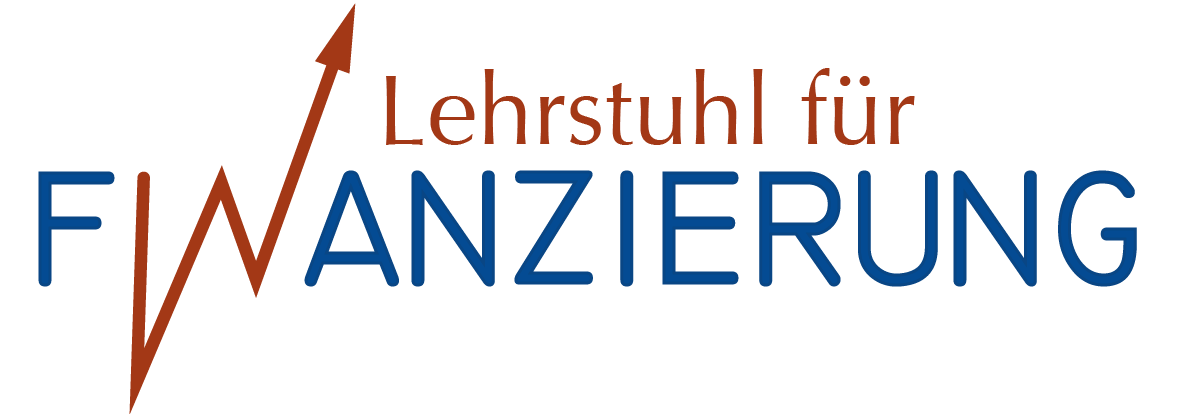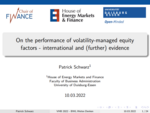Talks

Selected talks from our research team
- Schwarz, Patrick: Measuring Business Social Irresponsibility: The Case of Sin Stocks; 21th EUROFIDAI-ESSEC Paris December Finance Meeting (PDFM), 19.12.2023, Paris, FRA. AbstractDetails
Negative screening (of "sin" stocks) is the most common strategy used by socially responsible investors. There is no consensus in the literature whether these exclusions result in higher cost of capital (and hence higher expected returns) for targeted firms. The existing literature identifies sin companies using industry classification codes (IC). We propose an alternative measure of firms' exposure to sin activities (sinfulness) based on textual analysis (TA) of their annual reports. Sinfulness captures both cross-sectional and time-series variation in firms' exposure to sin activities. The correlation between the IC and TA sin indicators is only 0.69, with twice as many sin stocks in TA than in IC. TA reveals several important false positive and numerous false negative sin stocks in IC. While the number of publicly listed sin-related stocks has declined by 43% between 1997 and 2021, their total market capitalization has increased almost threefold from about $200bn to $600bn during the same period. A sin-weighted portfolio of sin stocks earns an annualized Fama-French 6-factor alpha of 4%. Overall, our study highlights important shortcomings of using IC to identify sinful firms and resurrects the sin premium, that is, more sinful stocks have higher expected returns.
- Schwarz, Patrick: Measuring Business Social Irresponsibility: The Case of Sin Stocks; 29th Annual Meeting of the German Finance Association (DGF), 29.09.2023, Hohenheim, GER. AbstractDetails
Negative screening (of "sin" stocks) is the most common strategy used by socially responsible investors. There is no consensus in the literature whether these exclusions result in higher cost of capital (and hence higher expected returns) for targeted firms. The existing literature identifies sin companies using industry classification codes (IC). We propose an alternative measure of firms' exposure to sin activities (sinfulness) based on textual analysis (TA) of their annual reports. Sinfulness captures both cross-sectional and time-series variation in firms' exposure to sin activities. The correlation between the IC and TA sin indicators is only 0.69, with twice as many sin stocks in TA than in IC. TA reveals several important false positive and numerous false negative sin stocks in IC. While the number of publicly listed sin-related stocks has declined by 43% between 1997 and 2021, their total market capitalization has increased almost threefold from about $200bn to $600bn during the same period. A sin-weighted portfolio of sin stocks earns an annualized Fama-French 6-factor alpha of 4%. Overall, our study highlights important shortcomings of using IC to identify sinful firms and resurrects the sin premium, that is, more sinful stocks have higher expected returns.
- Schwarz, Patrick: Measuring Business Social Irresponsibility: The Case of Sin Stocks; 20th Annual Corporate Finance Days (CFD), 21.09.2023, IÉSEG, Lille, FRA. AbstractDetails
Negative screening (of "sin" stocks) is the most common strategy used by socially responsible investors. There is no consensus in the literature whether these exclusions result in higher cost of capital (and hence higher expected returns) for targeted firms. The existing literature identifies sin companies using industry classification codes (IC). We propose an alternative measure of firms' exposure to sin activities (sinfulness) based on textual analysis (TA) of their annual reports. Sinfulness captures both cross-sectional and time-series variation in firms' exposure to sin activities. The correlation between the IC and TA sin indicators is only 0.69, with twice as many sin stocks in TA than in IC. TA reveals several important false positive and numerous false negative sin stocks in IC. While the number of publicly listed sin-related stocks has declined by 43% between 1997 and 2021, their total market capitalization has increased almost threefold from about $200bn to $600bn during the same period. A sin-weighted portfolio of sin stocks earns an annualized Fama-French 6-factor alpha of 4%. Overall, our study highlights important shortcomings of using IC to identify sinful firms and resurrects the sin premium, that is, more sinful stocks have higher expected returns.
- Schwarz, Patrick: Measuring Business Social Irresponsibility: The Case of Sin Stocks; 6th Annual Conference of the Global Research Alliance on Sustainable Finance and Investment (GRASFI), 23.08.2023, Yale University, New Haven, US. AbstractMeasuring Business Social Irresponsibility: The Case of Sin StocksDetails
Negative screening (of "sin" stocks) is the most common strategy used by socially responsible investors. There is no consensus in the literature whether these exclusions result in higher cost of capital (and hence higher expected returns) for targeted firms. The existing literature identifies sin companies using industry classification codes (IC). We propose an alternative measure of firms' exposure to sin activities (sinfulness) based on textual analysis (TA) of their annual reports. Sinfulness captures both cross-sectional and time-series variation in firms' exposure to sin activities. The correlation between the IC and TA sin indicators is only 0.69, with twice as many sin stocks in TA than in IC. TA reveals several important false positive and numerous false negative sin stocks in IC. While the number of publicly listed sin-related stocks has declined by 43% between 1997 and 2021, their total market capitalization has increased almost threefold from about $200bn to $600bn during the same period. A sin-weighted portfolio of sin stocks earns an annualized Fama-French 6-factor alpha of 4%. Overall, our study highlights important shortcomings of using IC to identify sinful firms and resurrects the sin premium, that is, more sinful stocks have higher expected returns.
- Schwarz, Patrick: Volatility-managed equity factors around the globe; 28th Annual Meeting of the German Finance Association (DGF), 30.09.2022, Marburg, GER. AbstractOn the performance of volatility-managed equity factors - international and further evidenceDetails
Motivated by the mixed evidence on the performance of (downside) volatility-managed equity factor portfolios in the U.S., I study the performance of nine (downside) volatility-managed equity factors before and after considering transaction costs in a set of 45 international equity markets. My results suggest that volatility management is most promising for market, value, profitability and momentum portfolios and that the performance can be enhanced by applying downside volatility instead of total volatility (variance) as a scaling factor. Nevertheless, a marginal trader would find it difficult to profit from these strategies as only the managed market and momentum strategies are partially robust to my transaction cost estimations. Collectively, my results suggest that the persistence of abnormal returns of (downside) volatility-managed equity factors can largely be explained by the associated transaction costs.
- Schwarz, Patrick: Volatility-managed equity factors around the globe; 100 Jahre VHB: Jubiläumstagung des Verbands der Hochschullehrerinnen und Hochschullehrer für Betriebswirtschaft e.V., 10.03.2022, Düsseldorf (digital). AbstractDetails
Motivated by the mixed evidence on the performance of (downside) volatility-managed equity factor portfolios in the U.S., I study the performance of nine (downside) volatility-managed equity factors before and after considering transaction costs in a set of 45 international equity markets. My results suggest that volatility management is most promising for market, value, profitability and momentum portfolios and that the performance can be enhanced by applying downside volatility instead of total volatility (variance) as a scaling factor. Nevertheless, a marginal trader would find it difficult to profit from these strategies as only the managed market and momentum strategies are partially robust to my transaction cost estimations. Collectively, my results suggest that the persistence of abnormal returns of (downside) volatility-managed equity factors can largely be explained by the associated transaction costs.



